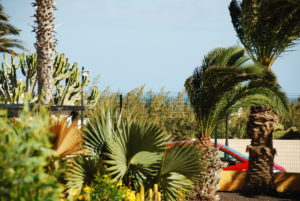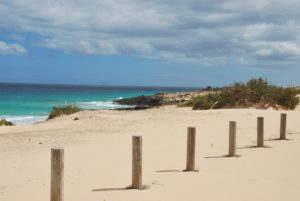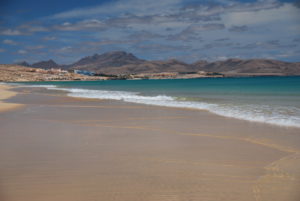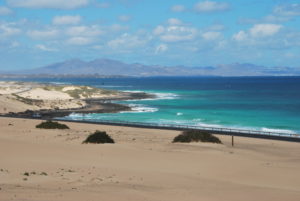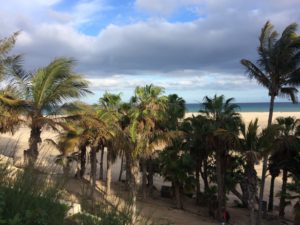Climate
The climate on Fuerteventura is pleasant throughout the year. The island is hence referred to as the island of eternal spring. The sea regulates air temperature, diverting hot Sahara winds away from the island. The island’s name in English translates as „strong fortune” or „strong wind”, the Spanish word for wind being viento. During the winter months, temperatures average a high of 22 °C (72 °F) and a low of around 15 °C (59 °F), whereas during the summer a mean high of 28 °C (82 °F) and a low of 20 °C (68 °F) can be expected. Precipitation is about 147 mm (6 in) per year, most of which falls in autumn and winter. December is the month with highest rainfall.
A sandstorm known as the Calima (similar to the Sirocco wind, which blows to the North of the Sahara, to Europe) may blow from the Sahara Desert to the Northwest, and can cause high temperatures, low visibility and drying air. Temperatures during this phenomenon rise temporarily by approximately 10 degrees Celsius. The wind brings in fine white sand, visibility can drop to between 100 to 200 m (328.08 to 656.17 ft) or even lower and can even bring African locusts to the island.
Beaches
Fuerteventura was chosen among 500 European destinations by the Quality Coast International Certification Program of the European Coastal and Marine Union as one of the most attractive tourist destinations for visitors interested in cultural heritage, environment and sustainability.
Tourism
The first tourist hotel was built in 1965 followed by the construction of Fuerteventura Airport at El Matorral, heralding the dawn of a new era for the island. Fuerteventura, with its 3,000 sunshine hours a year, was placed firmly on the world stage as a major European holiday destination. While having fully developed tourist facilities, the island has not experienced the overdevelopment found on some other islands and consequently caters for visitors attracted by its rugged natural beauty.
The summer Trade Winds and winter swells of the Atlantic make this a year-round surfers’ paradise, with more exposed areas on the north and west shores such as Corralejo and El Cotillo proving most popular. Wind surfing takes places at locations around the island. Sailors, scuba divers and big-game fishermen are all drawn to these clear blue Atlantic waters where whales, dolphins, marlin and turtles are all common sights. With many hills present throughout the Island, hikers are also attracted to this Island.
Excellent sandy beaches are found in many locations. Western beaches, such as those around El Cotillo, can experience strong surf. The beaches adjoining the extensive sand dunes east of Corralejo are popular, as are the more protected extensive sandy shores of the Playa de Sotavento de Jandia on the southeastern coast between Costa Calma and the Morro Jable. Naked sun bathing and swimming are the norm almost on all beaches.
Much of the interior, with its large plains, lavascapes and volcanic mountains, consists of protected areas, although there are organised tours and vehicular access across them.
Activities
There is Oasis Park (Safari and ZOO) 8km north of Costa Calma in La Lajita. If you are traveling with kids you have to go there. Every Sunday there is open market with local home made products.
Costa Calma is paradise for those who are doing water sports. Thereis the largest school of wind surfing and kitesurfing with access to the lagoon – Rene Egli.
A diving schools, marinas and fishing fish on the ocean are available as well.
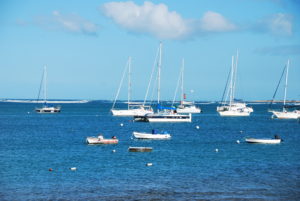
You can try desert rallies in mountainous terrain, quads and buggies are waiting for you next to our houses.

